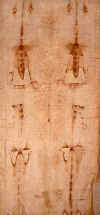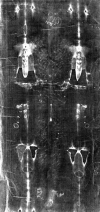Are
genetic defects -
price of
evolution?
Book
of Daniel
"Revelation" of John
The
signs of times
P16
There
were 14 most severe wounds on Jesus' body:
from the lashes (and at that time there were bone knobs on the lashes, used by
the Romans, and their disposition on a lash coincides with the traces on the
body), from the fall on a knee (when Jesus carried the cross), from the crown of
thorns on the head, from the puncture with a spear under the breast. According
to the doctor David Willis' announcement,
the wounds on head and body could not be received differently then how it was
described in the Gospels.
The
wounds received as a result of the crucifixion, attracted special attention. The
flow of blood outgoing from the wound on the left wrist specifies, that during
bleeding the hand was lifted up on 55-65 degrees. And it is compatible to the
crucifixion on a cross. So, to facilitate breath, the victim should have bent
hands in elbows and raise the body. Contrary to many medieval pictures of the
crucifixion, there on the Shroud the wounds from nails are on the wrist and not
on the palm as usually it was painted . And it is also the attribute of the
authenticity of the Shroud, because the nailed palms
couldn’t keep the weights of the body.
In
the photo: on the back part of the Shroud the traces from beating with the
lashes are seen on the back, buttocks and legs; lengthened hair and the traces
of blood on the head from the crown of thorns (the analyses of pollen found on
the Shroud confirmed that the crown was made of a kind of blackthorn growing in
the Jerusalem area. The plant has sharp thorns of 4-5 centimeters long!
Certainly, the crown put strong damages to the surface of the head).
The
wounds received as a result of the crucifixion, attracted special attention. The
flow of blood outgoing from the wound on the left wrist specifies, that during
bleeding the hand was lifted up on 55-65 degrees. And it is compatible to the
crucifixion on a cross. So, to facilitate breath, the victim should have bent
hands in elbows and raise the body. Contrary to many medieval pictures of the
crucifixion, there on the Shroud the wounds from nails are on the wrist and not
on the palm as usually it was painted . And it is also the attribute of the
authenticity of the Shroud, because the nailed palms
couldn’t keep the weights of the body.
The
most unexpected proof of the authenticity of the Shroud was given by Dr Pierre
Barbet, who studied every possible wound in 1930. He said that the nail passing
through the wrist touches the median nerve, therefore the large finger goes
inside (the experiment was made on the amputated hand). On the Shroud Jesus'
large fingers are hidden also.
The
wound on the left half of the breast between the 5th and the 6th
edges is clearly visible, which as a mirror reflection should be on the right
half, which also corresponds to the Bible. Blood proceeded from the wound, when
the body was in the vertical position and the flow of blood is in some places
interrupted by the clean strips. Dr Anthony Sava noted that there is often an
accumulation of fluid in the pleural cavity as a response to injury. Having
investigated the wounds on the back, shoulders and breast, doctor came to
conclusion that they could cause the accumulation of the liquid, and this
pleurisy caused by the
trauma was the basic reason of death, and the crucifixion on the cross
only strengthened the development of pleurisy.
The consent, to which medical experts came, was the following: the fabric of the Shroud beyond any reasonable doubt was in touch with a victim of the crucifixion.


